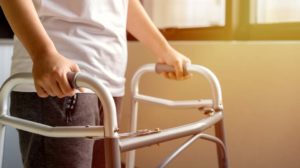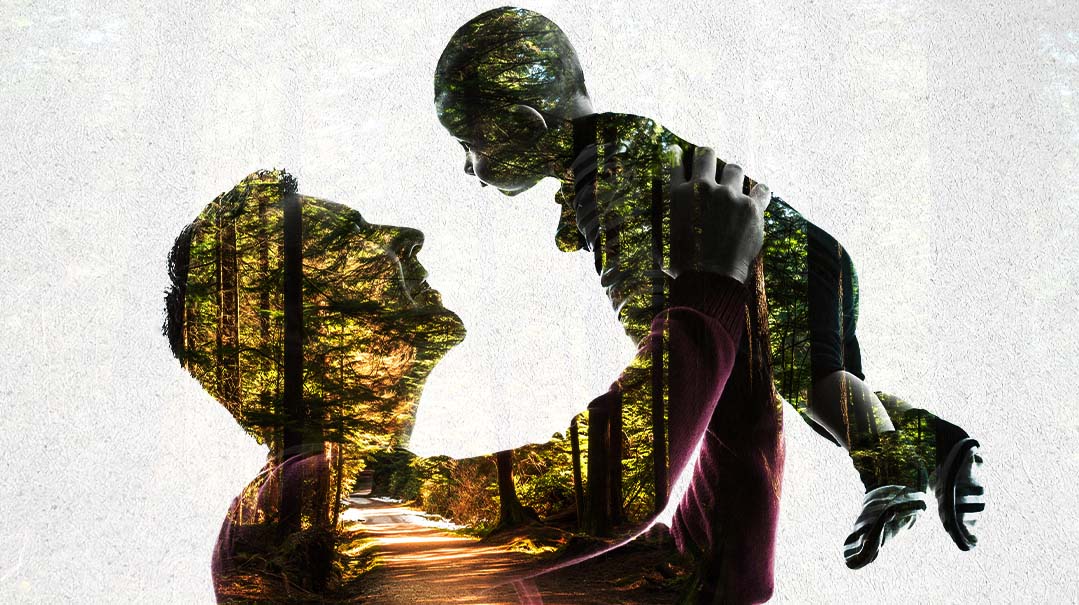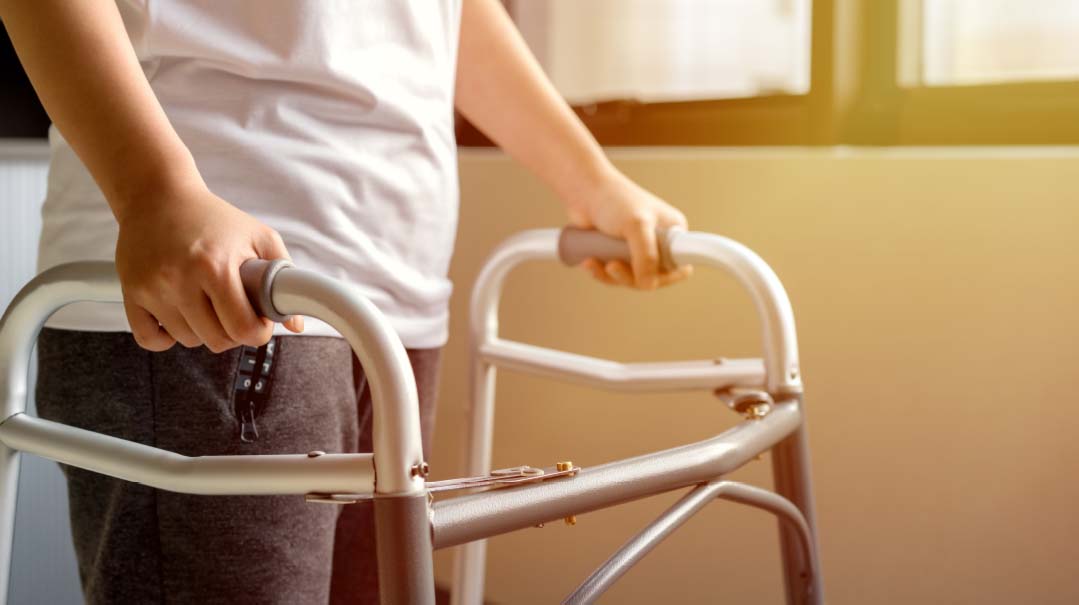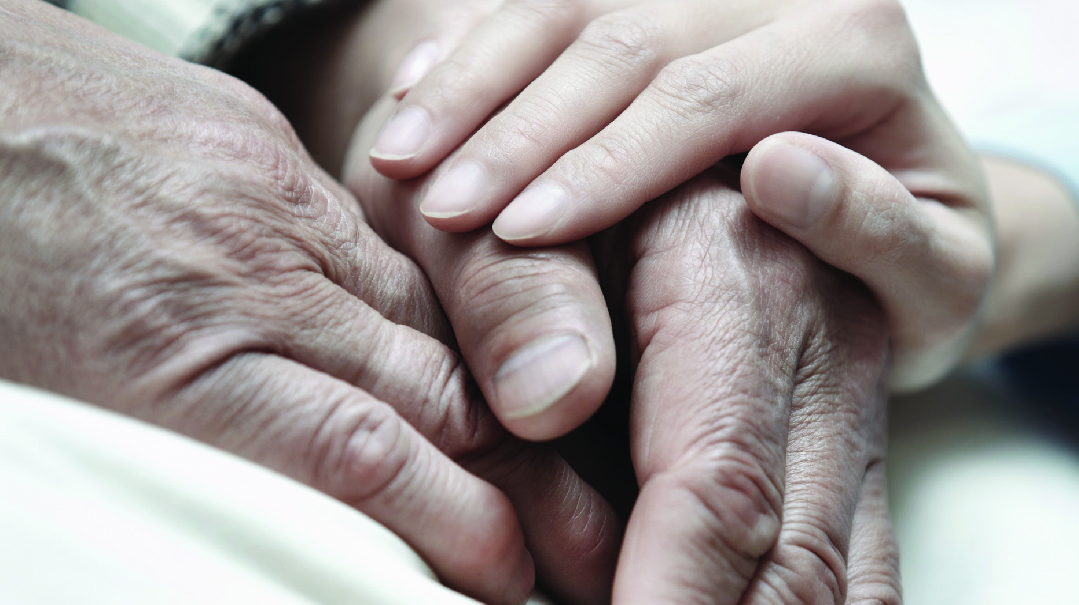Not All in My Head

My parents didn’t know what to think because the doctors insisted there was nothing wrong with me

Adrenaline rushes.
Asthma. Blood pooling. Blurred vision. Brain fog. Chest pain. Convulsive syncope. Costocondritis. Dizziness. Excessive sweating. Insomnia. Joint pain. Migraines. Muscle spasms. Nausea. Shaking. Stomach pain. Tachycardia. Temperature dysregulation. Vocal chord dysfunction.
I’m a 20-year-old girl, and the above is a partial list of the symptoms I experience regularly. My official diagnosis is hypermobile Ehlers–Danlos syndrome (hEDS) and postural orthostatic tachycardia syndrome (POTS). Having EDS basically means that my body’s connective tissue is faulty, and considering that connective tissue makes up something like 80 percent of the body, a problem in the connective tissue can cause anything from loose joints to extreme fatigue to rapid bruising. POTS is a disorder of the autonomic nervous system that causes problems with blood circulation. The form I suffer from causes my body to go into fight-or-flight mode at random, resulting in racing heart rate, light-headedness, brain fog, blurred vision, and extreme exhaustion.
Most people have never even heard of these conditions. And many doctors are not equipped to diagnose them.
I know, because my symptoms went undiagnosed for many years.
As a baby and young child, I suffered from all sorts of breathing issues: asthma, spasmodic croup, chronic bronchitis, and more. I basically outgrew these issues during childhood, but then, in eighth grade, I grew six inches in six months. And that’s when the real trouble started.
Until that point, I was a really good student, the type who could repeat back every point the teacher said or retell a speech literally word for word. Suddenly, however, my brain would start to get foggy in the middle of nowhere, and I would completely zone out for a few minutes. If this happened in class, I would find myself spacing back in only to realize that I had no idea what the teacher was talking about anymore. If it happened when I was talking to someone, I would start rambling about something tangential, then snap back into the conversation and have no recollection of what was being discussed.
At this point, I also started having all sorts of other weird symptoms, from headaches, stomachaches, and joint pain to dizziness, fatigue, shakiness, and near-fainting spells.
“Growing pains,” was my family doctor’s explanation. “Probably stress, too.”
He said that I felt my heart pounding because I was focusing on it, that my hands shook and I dropped things all over the place because I was nervous, that I was seeing stars and having breathing issues because I was hyperventilating.
“It’s all in your head, Faigy,” many people told me — including relatives, teachers and friends. They were convinced I was exaggerating, since from the outside I didn’t look sick; I alternated between looking spaced out or sleepy and looking tense and pent-up. My parents didn’t know what to think because the doctors insisted there was nothing wrong with me, but the way I was feeling and functioning belied what they were saying.
B
efore entering high school, I started seeing a psychologist, who was supposed to help me manage my stress and anxiety. She taught me stress-management skills that I already knew, and she kept reaching for the phone every time I coughed. I think I gave her anxiety. She let me go and told me my problems were not psychological.
Determined to get me a correct diagnosis, my parents persisted in taking me to one specialist after another. Every few months, I underwent a battery of tests, but none of them showed anything serious. By the time I started high school, I had seen about a dozen different specialists and therapists: a pulmonologist and a gastroenterologist; a speech language pathologist, a respiratory therapist, and an exercise therapist; an ear, nose, and throat specialist; a cardiologist, a neurologist, an allergist/immunologist, a pulmonary surgeon, and a radiologist. The only real diagnosis I got at that point was vocal chord dysfunction, which explained some of my breathing issues. I started going for speech therapy to learn breathing techniques so I could use my vocal chords correctly, and after that, the wheezing and choking feeling stopped.
In ninth grade, my breathing issues and asthma returned, and I also started having adrenaline surges. I could be sitting in class and suddenly my heart would start to race and I’d feel like I was about to faint. Other times, my muscles would spasm, or I would have a sudden coughing fit, or I’d start wheezing or feeling choked. Several times, the school called my parents to come get me, and my father or mother would pick me up and take me either to the emergency room or home to rest. But most of the time, I convinced myself that I was fine and just went out of class to rest for a bit with my nebulizer.
Once, when I was making odd breathing noises like a baby with croup, I called my parents from school and they took me home and then called 911. The medics who arrived took my vitals and told my parents I was having a panic attack, since my heart rate was extremely high. So I got to stay home from school that day.
I often felt stressed, but it seemed to me that the stress was physical, not emotional, because other than my body doing weird things, my life was fine. I had a great family, I had good friends, and I liked school, at least when I wasn’t experiencing brain fog.
At the beginning of tenth grade, I came down with a strange virus that made me so weak, I could barely move. I had to hold on to the walls to support myself so I shouldn’t fall. The pulmonologist prescribed two courses of steroids to help me breathe better, but these medications didn’t help — all they did was cause bizarre reactions. I’d wake up in the middle of the night bursting with so much energy that I’d bounce up and down on my bed until I fell over in exhaustion. I also felt an insane desire to bang my head against the wall. Shortly afterward, I started experiencing stomach pain, nausea, digestive issues, and constant burping that would set off my vocal chords and drive my lungs mad. It was a never-ending vicious cycle.
Since I was still having trouble breathing, I went for more tests: bronchoscopy, endoscopy, an impedance probe. The results of these tests were normal, and no one knew what to do for me. I was tested for asthma, and the results came back negative, which threw me into something of an identity crisis. If I didn’t have asthma, then why couldn’t I breathe? Thinking it was bronchitis, the pulmonologist prescribed long-term antibiotics.
Many people suggested that I go for yoga, and when the pulmonologist explained that it could improve my lung function, I signed up for yoga classes. These exercises actually did help my breathing, but they caused problems with my joints: My joints began to grind, causing severe pain throughout my body. I found myself tearing up from the pain, biting my lip to avoid screaming out, and calling my mother to come get me from school because I was in such agony.
But other people who did yoga kept gushing about it to me and assuring me that it was the cure to all my problems, so I persisted in doing it despite the pain it caused.
Until this point, I had been coping in school, despite all my symptoms. At the end of 11th grade, however, I became a completely different student because of the brain fog and pain. I could barely focus, and I looked like I was spacing out all day and didn’t care what was going on. I spoke in a monotone, using short, clipped sentences, and often had to leave the room in the middle of class.
The joint pain, mostly in my knees, was so unbearable at times that I would sit in class squeezing my knees so hard it hurt my hands. I could barely control a pen, and sometimes I would space out and write nonsense. At some point, I began typing notes on a computer because I couldn’t write. I also started having costochondritis, an inflammation in the chest that made me feel like I was having a heart attack. (A doctor later described it as the feeling that an elephant is sitting and stomping on your chest.)
Freaked out that I was going to die at any point, I went to my family doctor. She was not available, though, so I saw her coworker. Noticing that my cheeks were flushed, she suspected lupus, and referred me to a rheumatologist. Rheumatology, it seems, is where people get sent when no one else knows what to do with them. It was one of the few specialties I hadn’t yet encountered.
I spent the month before my appointment flipping out that maybe I wasn’t making all this up. When I finally met the rheumatologist, who was accompanied by a cadre of medical students, he asked me a million questions about every part of my body. My mother was shocked to hear that I had migraines every day; I had never even mentioned them to her because I thought it was normal to have brain-splitting headaches all the time. Most of my symptoms I didn’t actually think were problematic, because I had had them for so long that I thought they were normal.
“I’m referring you to a specialist out of town because I think you have POTS,” the rheumatologist said. “And you also have something called hEDS, which is why you’re having joint pain.” He showed me the list of POTS symptoms. Out of 30, I had 29.
Still, I was convinced that his diagnosis was wrong. I was so traumatized from doctors thinking I was crazy that I refused to admit I was in pain all over.
He kept asking, “Does this hurt?” but I wouldn’t say yes.
Shaking his head, he turned to the medical students and said, “Do you see this? This is what happens after four and a half years of not being believed. And she says she’s not in pain!”
He emphasized that my condition was genetic — the genes in my connective tissue are faulty, and that’s what causes all my issues. “You didn’t do this to yourself, and it’s not all in your head,” he told me. He sent us home with a paper and emails with more information that said in a few places, “This is a proven cause of chronic musculoskeletal pain.”
For a few days I was on a high from the validation. I frantically gathered any information I could about my diagnosis — and then it started to sink in and I got overwhelmed.
Wait! You mean this is going to be the rest of my life?
That was when I started to really grieve. Not just for the fact that I was sick, and would probably be sick for the rest of my life, but also for all the trauma of the past few years: for the painful and frightening symptoms I had experienced, for the bewilderment of not knowing what was causing them, and for the ever-present suspicion that it was all in my head. I’d be standing in front of the freezer and suddenly tears would start pouring down my face for no apparent reason. One day I looked at the water cooler, with the enormous jug atop it, and thought to myself, My tears this week alone would fill about three of those jugs.
Shortly before my diagnosis, I had joined a support group for frum girls with chronic medical conditions, and there I was introduced to something called ACT: acceptance and commitment therapy, in which you to learn to accept and tolerate unpleasant feelings or circumstances rather than avoid, fight, or deny them. Having the support of a mentor and friends who really understood what I was going through allowed me to eventually move toward true acceptance.
Acceptance, I learned, is a journey, not a destination. It’s not like, “Wow, okay, it’s all good.” I have to fight every day for more quality of life, more strength, more endurance, more symptom control, more pain relief. But doing so in the context of acceptance means that the fight doesn’t have that same edge of desperation, the same clinging to any slight hope for improvement and then devastation when it doesn’t work out. I know that things sometimes get worse, but they also sometimes get better.
Instead of thinking of myself as a fragile eggshell that can break at any moment and be shattered forever, I’ve learned to see myself as separate from my condition. My body may be sick, but I’m not. I am not my pain — I am how I deal with that pain.
The rheumatologist recommended I go for physical therapy and occupational therapy. He also banned me from yoga for life.
“Your joints are hypermobile and don’t know their limits,” he explained. “By stretching them through yoga, you’re actually destroying them.”
I started hydrotherapy, and began taking salt tablets, magnesium supplements, and other medications and dietary supplements, since my body doesn’t process certain nutrients normally.
As Hashgachah had it, I wound up seeing an occupational therapist who had just then been transferred to this department because she had recently suffered an injury — and she herself suffered from, of all things, EDS and POTS. She was married and had a successful career, and besides the validation and coping strategies she gave me, just seeing her gave me hope. She had amazing tips for reducing pain and getting better sleep, such as sleeping on memory foam to hold the joints together.
Not wanting to turn me into an invalid, my parents had always made a point of treating me normally, rather than pitying me or making allowances for my limitations. I couldn’t stand and wash dishes? Fine, so sit on a stool by the sink and wash dishes. Early on, they told me it’s my choice whether to go to the ER, unless it was a true emergency. They encouraged me to schedule my own doctor appointments, call the doctor with questions, and pick up my own medications from the pharmacy.
All this gave me some semblance of control, which is the wrong word because only Hashem is in control, but still it was important for me to feel that I am not just a helpless victim. Like any teenager, I was fiercely protective of my independence, and being treated like a responsible adult spurred me to do whatever I could to help myself and allowed me to avoid falling into despair and depression.
At the same time, my parents always advocated for me, and didn’t give up on getting me a diagnosis, even when test after test came back fine and doctor after doctor said there was nothing wrong with me. For five years, my mother kept schlepping me to one specialist after another, insisting there was something that was being missed.
When I was finally diagnosed, my family doctor admitted to my mother, “If she were my kid, she would have been dead on the side of the road three years ago.”
After my diagnosis, when my mother no longer felt that she had to fight to figure out what was wrong with me, she would drive me to my medical appointments and wait outside while I spoke to the doctor, respecting my privacy and encouraging me to take responsibility for my own care. She also taught me how to deal with the insurance company and process all the paperwork that I required. Sometimes, I would be in tears while on the phone with a particularly difficult medical secretary, and my mother would stand by my side texting me and giving me the tools and cues to get through the situation myself, so I could subsequently handle it all on my own.
I hate being a burden, so even though it was an adjustment to take care of my own medical and insurance stuff, and it was definitely annoying in the beginning, ultimately I was really happy that I didn’t have to bother my parents each time I had a medical question or a bill to submit to the insurance company.
Having an accurate diagnosis means that I can actually get the right treatment and medications for my symptoms, and I am in a much better place now, health-wise, than ever before. I have a job and a busy social life, and while I still struggle with a slew of unpleasant, even miserable symptoms, I know that with Hashem’s help I can look forward to a normal and productive life.
But even now that I have a diagnosis, people’s reactions to my condition range from unhelpful to downright maddening.
“Oh, it’s all stress,” they tell me, waving their hands knowingly. “Let me tell you about these great deep-breathing exercises.” Or, they’ll say, “Did you ever try juicing?”
I can’t even count how many people have insisted that juicing is the cure to all my symptoms. It’s tempting to respond to these people that if I went on a juice diet, I would land in the hospital due to low blood sugar, blood pressure fluctuations, or electrolyte imbalance.
Oh, and my favorite suggestion of all: “Did you try the Sarno method?”
Now, I have no doubt that many people have been helped through Dr. Sarno’s mind-body approach, or by juicing, for that matter, and I’m truly happy for them. But those methods are completely wrong for me, and when people who know nothing about my condition flippantly throw out these suggestions, it’s completely invalidating. I’m into acceptance and commitment therapy, in which you look your pain in the eye, accept it, and say, “I’m going to live my life anyway,” and for me, that’s a lot healthier and more realistic than attributing my symptoms to buried emotional pain.
I think it’s amazing that the frum community has become so much more aware of the various types of mental illness. The problem, for me, is that my specific condition — which, on the outside, can resemble panic attacks or other mental health issues — is physical, not mental. Paradoxically, therefore, the increased awareness of mental health has served to create greater stigma for my very physical illness, because people assume it’s psychosomatic and urge me to seek psychological intervention instead of the medical help I need.
I take the medications and dietary supplements my doctors recommend, based on science and research, and I ignore the many well-intentioned suggestions I receive. If I blithely attributed my symptoms to emotional pain, I would be fainting all over the place, walking around with partially or fully dislocated joints, and causing irreversible damage to my ligaments and tendons. Or I’d be seizing on the floor with my eyes rolling back and trying to take deep breaths and stay mindful as my heart rate spikes and my skin turns gray and blue.
I don’t blame people for thinking I’m having a panic attack when, in reality, my autonomic nervous system is just out of whack. But when they insist that I must be suppressing my emotions, or suffering from stress at home, well, that’s painful.
Statistics show that young people between the ages of 15 and 30 living with a chronic illness are three times more likely to attempt suicide than their healthy peers. But I believe that this high suicide rate is not due to the pain and other symptoms that destroy your life. It’s because of the feeling that people don’t believe you, that they think you’re crazy, that they’re convinced it’s all in your head and if you only got help with your stress and anxiety you’d be just fine, especially if you’d add some probiotics or fresh carrot and beet juice. The fact is that many chronic illnesses, like EDS and POTS, are largely invisible, and looking at a sufferer, you’d never believe the symptoms they describe are as bad as they claim.
Now that I am part of a support group, I can actually handle people’s comments quite well, because I just go and email my mentor and friends and we laugh hysterically about it. Laughing is the general approach we take to our illness: Let’s laugh about how sick we are, and then we’ll move on with life. If you can laugh, that means you accept your condition but don’t allow it to define you.
Here’s a poem I wrote that summarizes my attitude:
People like to comment
It doesn’t matter if I don’t want it
Everyone has something to say
Contradicting what they said yesterday
Convinced that what they told me
Of all things, that’s the key
And only they know how to fix me
“Ever heard of Doctor Sarno?
He helped a lot of people, you know.”
“How about Botox, have you ever tried that?”
“You’re just trying to get attention — stop being a brat!”
“Not sure if you realize, but it’s all psychological.”
“Maybe you should take a Tylenol?”
So I’ll nod and smile
Hoping they’ll leave after a while
I know they’re just showing their love
And this is just a test sent from Above
Slowly I’m learning
They just don’t want to see me hurting
Yet all these things people blurt
It can really, really hurt
But it’s my decision
I don’t have to listen.
Hashem gave me two ears —
One for it to go in. One for it to go out.
It’s great that people out there realize that anxiety is real, that depression is real, that mood and personality disorders are real. One day, soon I hope, people will start realizing that chronic illness is real, too.
(Originally featured in Mishpacha, Issue 802)
Oops! We could not locate your form.











